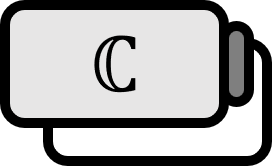Circles are invariant under bilinear transformation in the extended complex plane.
Theorem 1
Every bilinear transformation maps a circle described by $\overline { \mathbb{C} }$ to another circle described by $\overline { \mathbb{C} }$.
Proof
Let’s represent the general equation of a circle as $$ a ( x^2 + y^2 ) + 2p x + 2q y + c = 0 $$ and if we set $B := p - iq$, for the $z = x + i y$ on the complex plane we can obtain $$ az \overline{z} + Bz + \overline{Bz } + c = 0 $$ Now, proving that the same form is maintained even if we apply the linear transformation $\displaystyle w = {{z - \beta} \over {\alpha}}$ and inversion $\displaystyle w = {{1} \over {z}}$ to $az \overline{z} + Bz + \overline{Bz } + c = 0$ concludes the proof.
Case 1. Linear Transformation
Since $z = \alpha w + \beta$, we have $$ a \alpha \overline{\alpha} w \overline{w} + (a \alpha \overline{\beta} + \alpha B ) w + (a \overline{\alpha} \beta + \overline{\alpha B} ) \overline{w} + ( a \beta \overline{ \beta } + ( \beta B + \overline{\beta B} ) + c ) = 0 $$
Case 2. Inversion
Since $\displaystyle z = {{1} \over {w}}$, we have $$ a + B \overline{w} + \overline{B} w + c w \overline{w} = 0 $$ Considering the property of the conjugate complex number, one can see the new equation is of the same form as $az \overline{z} + Bz + \overline{Bz } + c = 0$.
■
Explanation
The extended complex plane refers simply to the extension of the complex plane $\mathbb{C}$ by adding infinity $\infty$. Though crudely, if we were to express it mathematically, it would be represented as $\overline { \mathbb{C} } = \mathbb{C} \cup \left\{ \infty \right\}$, and it’s alright to think of $\infty$ as ’the end of the plane’. In this sense, $\infty$ exists anywhere without distinction, infinitely far from the origin, regardless of the direction, naturally without discrimination of positive or negative aspects.
Since a circle is defined by three points not lying in a straight line, considering the above theorem, it’s sufficient to only concern ourselves with those three points. Meanwhile, in the extended complex plane, if we think of a line as connecting infinity $\infty$ at both ends, it can be seen as defining a circle with three points. If we could bend space, these would form an exact ‘circle’ on the surface of a cylinder rolled up from the complex plane.
If one can accept this explanation, the following corollary should also come naturally. For the discussion of conformal mappings, this fact is very important, so even if it’s not entirely convincing, it’s still worth knowing as a fact.
Corollary
Every bilinear transformation maps a straight line described by $\overline { \mathbb{C} }$ to another straight line described by $\overline { \mathbb{C} }$.
Osborne (1999). Complex variables and their applications: p202. ↩︎
